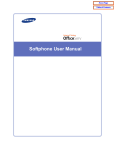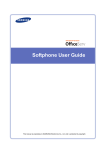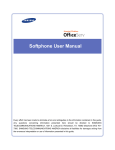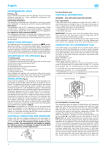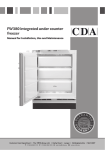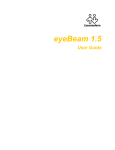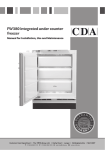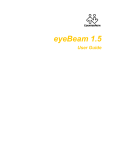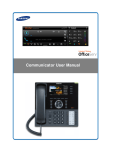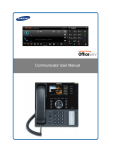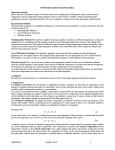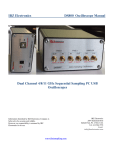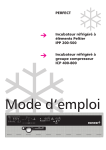Download OfficeServ Softphone User Manual
Transcript
Softphone User Manual TABLE OF CONTENTS INTRODUCTION 4G Conventions ............................................................................................................................... 4G Major Functions of OfficeServ Softphone................................................................................... 4G OfficeServ Softphone Setup....................................................................................................... 6G THINGS YOU SHOULD KNOW 15G Introduction to the OfficeServ Softphone ................................................................................. 15G Windows of OfficeServ Softphone ........................................................................................... 17G Status Display LED .................................................................................................................. 24G Button LEDs............................................................................................................................. 24G Taskbar Icon Menus................................................................................................................. 25G OfficeServ Softphone Option Settings ..................................................................................... 26G Speaker and Microphone Setting (System Setting) ................................................................. 59G MAKING A CALL 66G Before Making a Call................................................................................................................ 66G Making an Intercom Call .......................................................................................................... 70G Making an External call............................................................................................................ 74G Making an Intercom/External call ............................................................................................. 81G ANSWERING A CALL 85G Before Answering a Call........................................................................................................... 85G Answering an Intercom Call ..................................................................................................... 87G Answering an External call....................................................................................................... 89G Answering an Intercom/External call........................................................................................ 91G CONVENIENT FEATURES 94G Features Used During a Call.................................................................................................... 94G Call Forwarding...................................................................................................................... 102G Do Not Disturb (DND) ............................................................................................................ 106 2 © SAMSUNG Telecommunications America, L.P. Page ...................................................................................................................................... 108G Message .................................................................................................................................117G Boss/Secretary....................................................................................................................... 120G Group..................................................................................................................................... 122G Caller ID Check...................................................................................................................... 124G MENUS 126G Directory ................................................................................................................................ 126G Message Box/Call Log ........................................................................................................... 136G ANNEX 143G USB Handset/Sound Card ..................................................................................................... 143G © SAMSUNG Telecommunications America, L.P. 3 INTRODUCTION Conventions CHECKPOINT Provides the operator with checkpoints for stable system operation. NOTE Indicates additional information for reference. Major Functions of OfficeServ Softphone Speed Dial AOM Users can save frequently dialed numbers as speed dial numbers and make a call just by pressing the corresponding speed dial button. Call Pickup This function allows you to pick up a call ringing at another station by either dialing Call Pickup feature code plus the extension number of the ringing station, or if you have a DP key assigned with a station number, press this DP key with the flashing light to answer this ringing station. Redial If the recipient is busy, users can use automatic redial/retry, callback, or camp on function to connect to the recipient after the recipient finishes the call. 4 © Samsung Telecommunications America, L.P. Call Hold/Call Transfer The call hold or call transfer function allows the user to hold a call for a short time or to transfer the call to another person if the user must Hold attend to an urgent matter or if another call arrives. Conference/Group Conference This function allows up to 5 people to speak to one another at the same time. Call Forwarding This function allows you to forward your calls to another station, group of stations or an external telephone number. DND This function allows you to block calls to your Softphone. Page This function allows the user to deliver an announcement through the keypset speakers or through the external paging speakers. Boss/Secretary This function allows a secretary to transfer an external call to the boss conveniently. Caller ID Display This function displays the caller number and name from the main window when a call arrives. © Samsung Telecommunications America, L.P. 5 OfficeServ Softphone Setup Check the following items before installing the OfficeServ Softphone program. Preparations Prior to Installation The following items must be checked before installing the OfficeServ Softphone program. Preparations Prior to Installation Please check the following system requirements before installing the OfficeServ Softphone into your PC. Specification Category Operating System Windows 2000 Series(Professional, Server, and Advanced Server) Windows XP Professional Processor(CPU) Pentium 4, 1.6 Ghz or higher Memory 512 Mbytes (or higher) HDD 20 Gb (or larger) Network Interface Card 10/100BASE-T Sound Card Bi-directional sound card Others USB Headset recommended (or microphone and speaker) Checkpoints Check the following items before installing the OfficeServ Softphone program. After installing the OfficeServ Softphone program, the MCP IP address of the system server connecting the OfficeServ Softphone to the OfficeServ system, and the Device ID and password required for starting the OfficeServ Softphone must be entered. 6 © Samsung Telecommunications America, L.P. OfficeServ Softphone Program Installation After checking the checkpoints before installing the OfficeServ Softphone program, follow the steps described below and install the OfficeServ Softphone program. 1. 2. 3. 4. Download the OfficeServ Softphone installation program from the web site that introduces the OfficeServ system. Double click the ‘OfficeServ Softphone Install_version.exe’ file to start the InstallShield Wizard. Once the installation preparation window appears, a window that prompts you to select a country where OfficeServ Softphone will be used appears. Click [Next>] button to start program installation. If you do not want to install the program, click [Cancel] button. © Samsung Telecommunications America, L.P. 7 5. 6. After reading the OfficeServ Softphone license agreement, click [Yes] button to proceed with the installation or click [No] button to cancel the installation. Designate the installation folder and click [Next>] button. OfficeServ Softphone Program Installation Folder The installation folder is set to ‘C:Program Files\OfficeServ Softphone’ by default. Click [Browse...] button to select another folder and click [Next>] button. 8 © Samsung Telecommunications America, L.P. 7. 8. Enter the program folder name, and then click [Next>] button. The program folder name is set to ‘Samsung OfficeServ Softphone’ by default. A window appears and shows that the program files are being copied to the installation folder. © Samsung Telecommunications America, L.P. 9 9. The following window appears upon successful installation: Click [Finish] button and finish the installation. OfficeServ Softphone Shortcut Icon Once the OfficeServ Softphone program is properly installed, a shortcut icon is created and displayed on the desktop. 10 © Samsung Telecommunications America, L.P. Initial Environment Settings for the OfficeServ Softphone This section describes how to setup the login information when using the OfficeServ Softphone for the first time. 1. 2. From the Windows desktop, double click the ‘Softphone Shortcut Icon’ or select [Start] Æ [Programs(P)] Æ [Samsung OfficeServ Softphone] Æ [Samsung OfficeServ Softphone]. If you run the program for the first time after installing OfficeServ Softphone, the login information settings dialog box will appear as shown in the figure below: Initial Configuration of OfficeServ Softphone - When starting the OfficeServ Softphone for the first time after installing the program, the login information must be set. - Click [Login Info.] or [Cancel] button from the login information settings dialog box. Then, select [Option Cofig.] Æ [System Config.] Æ [Login Info.] in sequence from the initial window of OfficeServ Softphone to set login information. © Samsung Telecommunications America, L.P. 11 3. 4. 12 Click [Cancel] button from the login information settings dialog, and then click [Option Config.] icon( ) from the <OfficeServ Softphone starting> window. Select [System Config.] tab of the <OfficeServ Softphone Configuration> window. © Samsung Telecommunications America, L.P. 5. Click [Login Info.] of <System Config. Tab> window. 6. Set the Login information of OfficeServ Softphone. • System MCP IP: Enter the MCP IP of the OfficeServ system to which the OfficeServ Softphone will be connected. • Device ID: Enter the station number for the OfficeServ Softphone. • Password: Enter the password for the OfficeServ Softphone Device ID. © Samsung Telecommunications America, L.P. 13 OfficeServ Softphone Login Info Setup The login data of OfficeServ Softphone must be entered accurately in order to start the OfficeServ Softphone program. Consult your system administrator if the login data is unknown. 7. Click 8. The re-login message appears. Click [OK] button. . Applying Login Info. After setting the login data, the OfficeServ Softphone program must be restarted to apply the login data to the program. OfficeServ Softphone License Check Check the license of the OfficeServ Softphone program from the OfficeServ system when you log into OfficeServ Softphone. If a license error occurs, you cannot log into OfficeServ Softphone properly. In such a case, contact the OfficeServ system administrator. 14 © Samsung Telecommunications America, L.P. THINGS YOU SHOULD KNOW Introduction to the OfficeServ Softphone Intercom Calls Making an intercom call means that the OfficeServ Softphone user who is connected to the phone system at the user’s office makes a call to another internal OfficeServ Softphone (or keyphone) user. © Samsung Telecommunications America, L.P. 15 External Calls Making an external call means that the user makes a call to external numbers (e.g., home) or answers a call from outside places by using the OfficeServ Softphone (or keyphone) directly connected to the PBX of the central office. 16 © Samsung Telecommunications America, L.P. Windows of OfficeServ Softphone Initial Window of OfficeServ Softphone Status display LEDs Main window Minimize Button Hide Button Direction Button Function Icon Show NumPad button Send/Cancel/End button Redial/Mute Button Speaker Volume Bar Microphone Volume Bar Dial Button Conference/Screen/Transfer/ Hold/Speaker Button © Samsung Telecommunications America, L.P. 17 Part Name and Features Status Display LED This LED displays the OfficeServ Softphone status(e.g., busy, station ring) as colors. For detailed information, refer to the ‘Status Display LED’ of ‘Things you should know’. Main window The main window displays available menus, call processing status, various messages, and icons indicating the function setting status. : Boss/Secretary : USB phone connection : Call Forwarding status : Softphone Lock : Mute : Answer Mode : Alarm : DND : Message : Message reception status : Network Connection Status Minimize Button This button is used to minimize the <OfficeServ Softphone program> window. Hide Button This button is used to hide the <OfficeServ Softphone program> window and to display the program as an icon in the taskbar. Direction Button This button is used to move each menu when MMC function codes are set. Function Icon - [Directory]: Uses the Personal Directory menu. - [Device Config.]: Sets personal information on OfficeServ Softphone users, wakeup call, alarms, and ringing sound. - [Message]: Uses the Message or Call Log menu. - [Option Config.]: Sets environments for using OfficeServ Softphone. 18 © Samsung Telecommunications America, L.P. Show NumPad button This button is used to show or hide the <NumPad> window. [Send]/[Cancel]/[End] - [Send]: This button is used to make or to answer a call. - [Cancel]: This button is used to delete a phone number or a function code in Enbloc Dial Mode. - [End]: This button is used to end a call or to cancel a selected function. [Redial]/[Mute] - [Redial]: This button is used to dial the most recently dialed number. - [Mute]: This button is used to block sound(from the caller) during a call. Speaker Volume Bar This bar is used for adjusting the speaker volume. The output level of the speaker is displayed in a graph during a call. Microphone Volume Bar This bar is used for adjusting the volume of the microphone. The output level of the microphone is displayed in a graph during a call. Dial Button - Number Button: This button is used to enter a phone number or a function index. - [∗], [#]: This button is used to enter ‘∗’ and ‘#’ or to find a function index. [Conference]/[Screen]/[Transfer]/[Hold] - [Conference]: This button is used for conference calls. - [Screen]: This button is used to show or hide the <AOM> window. - [Transfer]: This button is used to transfer a connected call or to set a function code. - [Hold]: This button is used to briefly put a connected call on hold. - [Speaker]: This button is used to make or to answer a call. © Samsung Telecommunications America, L.P. 19 AOM Window The <AOM> window displays functions of the OfficeServ system as if displaying speed dial buttons. Users can use a function by clicking the corresponding button. Users can display the <AOM> window by clicking while in standby state or during a at the upper right section of the window to close the <AOM> window. call. Click Items Displayed in the <AOM> Window Items are displayed in the <AOM> window according to the functions set at the OfficeServ system. 20 © Samsung Telecommunications America, L.P. Using the AOM Window Users can use functions conveniently by clicking the button of the corresponding function from the <AOM> window. 1. Click 2. Select a function button from the <AOM> window. while in standby state or during a call to display the <AOM> window. © Samsung Telecommunications America, L.P. 21 Soft Menu Window The <Soft Menu> window displays convenient features of OfficeServ Softphone as menus. Click a menu to use a specific function. <Soft Menu> Window in a standby state The figure below is an example of a <Soft Menu> window displayed by right clicking the main window while in standby state: <Soft Menu> Window in a Busy Status The figure below is an example of a <Soft Menu> window displayed during a call. 22 © Samsung Telecommunications America, L.P. Using the <Soft Menu> Window Select and use a function from the displayed <Soft Menu> window. Boss Status Display Window The <Boss Status Display> window displayed only for Softphone where the Boss/Secretary function is set. Secretaries can conveniently manage the absent status of the Boss. This window can be opened by clicking the Boss/Secretary function is configured. © Samsung Telecommunications America, L.P. of an OfficeServ Softphone where 23 Status Display LED This LED displays the status of OfficeServ Softphone according to the operating status. Description Item Busy Red LED stays on. Station ring Red LED flashes. CO line ring Red LED flashes. Re-incoming ring Red LED flashes. Message Red LED flashes. DND Red LED flashes rapidly every 0.3 seconds. Button LEDs LEDs equipped on [Transfer], [Hold], [speaker], and [Mute] display the operating status. Description Icon Red light on: Transfer button red light is only on when call forward has been set. Red light flashes: CO line has been locked. Red light on: OfficeServ Softphone has been entirely locked. Red light on: A number has been entered, or [Send] or [Speaker] has been selected. Red light on: Mute button was pressed during a conversation. 24 © Samsung Telecommunications America, L.P. Taskbar Icon Menus Right click the Windows OfficeServ Softphone icon( popup menu as shown below: ) at the Windows taskbar to display a Description Item Softphone Open (F) To activate a deactivated <OfficeServ Softphone program> window. Directory (A) To use the Directory menu. For detailed information, refer to the ‘Directory’ of ‘Menus’. Message (M) To use the message box or call history menu. For detailed information, refer to the ‘Message/Call Log’ of ‘Menus’. Forward (F) To set a station number to which arriving calls will be forwarded when you cannot answer calls or while not using the Softphone. For detailed information, refer to the ‘Call Forward Tab’ section of ‘OfficeServ Softphone Option Settings’ of ‘Things you should know’. Device Config. (C) To set personal info, wakeup call, alarm, skin, and bell. For detailed information, refer to the ‘Device Config. Tab’ section of ‘OfficeServ Softphone Option Settings’ of ‘Things you should know’. System Config. (S) To set various options of the system. For detailed information, refer to the ‘System Config. Tab’ section of ‘OfficeServ Softphone Option Settings’ of ‘Things you should know’. Option(O) To set general options of the OfficeServ Softphone program. For detailed information, refer to the ‘Option Tab’ section of ‘OfficeServ Softphone Option Settings’ of ‘Things you should know’. Softphone Exit(X) To close the OfficeServ Softphone program. © Samsung Telecommunications America, L.P. 25 OfficeServ Softphone Option Settings Option Tab The [Option] tab allows you to set regular options required for using OfficeServ Softphone. 26 1. Click [Option Config.] icon( 2. Select [Option] tab of the <Softphone Configuration> window. ) in the <OfficeServ Softphone starting> window. © Samsung Telecommunications America, L.P. Item Normal Option Description Run on Windows Enables OfficeServ Softphone to run automatically when starting Startup Windows. Always on Top Enables the OfficeServ Softphone window to be always located above other programs. Beep on Ringing Allows you to be notified by a beep sound, which is a speaker sound from the PC, when a call is connected or a new message arrives. This option allows you to use the call pickup function because you can hear a new call easily. Call Connect Automatically displays the Memo window when a call is connected. Memo Screen Pops View OfficeServ Users can view news through the <OfficeServ News> window. News new Window This function is provided only when [NEWS/CALL] item is set at the <AOM> window. This feature is currently not supported in the US Market. - News Scroll Speed: Allows you to set a news scroll speed(Slow/Normal/Fast) in the <OfficeServ News> window. - News Font Color: Allows you to set a news scroll color in the <OfficeServ News> window. Message Program Key Allows you to set button layout(1 Column/2 Columns/3 Columns) in Column the <AOM> window. View Message Enables a message to be displayed when the message is received. Upon receipt - Message Alarm: Allows you to set a sound used for notifying message arrival. Message Alarm Allows you to set the cycle of an alarm when a message is received. Repeat - Once: An alarm rings only once when a message is received. - Every 2 Min.: An alarm rings every two minutes until you check a message. - No Tone: An alarm does not ring even when a message arrives. Debug Log Save Log Data of If problems occur continuously between OfficeServ Softphone and UDP Packet the system, the exchanged messages are saved as log files. Log files are created in the ‘C:\Temp’ directory. The files are later used for analyzing the problems. © Samsung Telecommunications America, L.P. 27 News Font Color 1. 2. 3. 28 Click [News Font Color] button of [Option] tab window. Select one of the basic colors or select [Define Custom Colors >>] button to customize the color. Click . © Samsung Telecommunications America, L.P. Message Alarm 1. 2. Click [Message Alarm] button of [Option] tab window. Select a wave file to be used as a message alarm from the default message alarms. Or, click [Search] button to select another wave file. 3. Click 4. Click to listen to the wav file beforehand. . © Samsung Telecommunications America, L.P. 29 Status Info 30 1. Click [Status Info] button of [Option] tab window. 2. Verify the OfficeServ Softphone setting and registration status. 3. Click . © Samsung Telecommunications America, L.P. Device Config. Tab The [Device Config.] tab allows you to set user profiles, wakeup calls, alarms, skins, or ringing sounds. 1. Click [Option Config.] icon( 2. Select [Device Config.] tab of the <Softphone Configuration> window. © Samsung Telecommunications America, L.P. ) of the <OfficeServ Softphone starting> window. 31 Option Preference User Station Name Description Allows you to set a name to be displayed in the recipient’s Softphone when making a call. Change Password Allows you to change a password that enables privacy and phone initialization. Privacy Option Allows you to set options to prevent other users from using the user’s profile and set the privacy function in the Directory, message box, and calling history check. Alarm Wakeup Call Allows you to set a wakeup call. Alarm Clock Allows you to set two alarms. Skin Select Skin Allows you to change the skin of OfficeServ Ring Select Ring Tone Allows you to change a phone ring sound. Softphone. Change Password 1. 32 Click [Change Password] button of [Device Config.] tab window. © Samsung Telecommunications America, L.P. 2. 3. Enter the previous password and the new password. • Password: Enter password. (Default password is ‘1234’.) • New Password: Enter a new password. • Re-type Password: Re-enter and confirm the new password. Click . When you forgot your password In such a case, contact the OfficeServ system administrator. . © Samsung Telecommunications America, L.P. 33 Privacy Option 1. Click [Privacy Option] button of [Device Config.] tab window. 2. Enter the password and click [OK] button. Entering Password for Privacy Option The password for privacy option should be entered accurately. Otherwise, the privacy function cannot be used. 34 © Samsung Telecommunications America, L.P. 3. 4. Click [Save] button to configure the privacy function or click [Clear] button to clear the privacy function. Click [OK] button. Setting Privacy Function In order to set the privacy function, the password must be entered when using [Option Config.], [Directory], [Message] menu and recent call log. © Samsung Telecommunications America, L.P. 35 Wakeup Call 36 1. Click [Wakeup Call] button of [Device Config.] tab window. 2. Configure the wakeup call function. • Repeat: Set the wakeup call interval. T No: The wakeup call function is deactivated. T Everyday: The wakeup call function is performed every day at a set time. T Mon.~Fri.: The wakeup call function is performed only during Mondays through Fridays. T Mon.~Sat.: The wakeup call function is performed only during Mondays through Saturdays. • Time: Set the time of the wakeup call. • Ring: Set the ringing sound of the wakeup call. © Samsung Telecommunications America, L.P. 3. Click 4. Click 5. Click to select a wave file to be used as a wakeup call sound. to listen to the wav file beforehand. . Setting a Wakeup Call Two alarms can be set in ‘Wakeup Call’. If a wakeup call is set, an alarm rings and a message is displayed at the set time. If the ringing sound is not defined, only the message appears at the set time. Alarm Clock 1. Click [Alarm Clock] button of [Device Config.] tab window. © Samsung Telecommunications America, L.P. 37 2. Configure the alarm function. • Time: Set the time of the alarm. • Repeat: Set the alarm interval. T No: The alarm function is deactivated. T Everyday: The alarm rings everyday at the set time. T Once: The alarm rings only once at the set time. • Ring: Set the ringing sound of the alarm. 3. Click 4. Click 5. Click to select a wave file to be used as an alarm sound. to listen to the wav file beforehand. . Setting Alarm If an alarm timer set, an alarm rings and a message is displayed at the set time. If the ringing sound is not defined, only the message appears at the set time. 38 © Samsung Telecommunications America, L.P. Select Skin 1. Click [Select Skin] button of [Device Config.] tab window. 2. Select a skin for OfficeServ Softphone. What is Skin? A skin is a graphic file used to change the appearance of the user interface in the OfficeServ Softphone program. If only a skin is changed, only appearance of the user interface will be changed and program functions will not be changed. 3. Click [OK] button. The skin window is displayed as shown below: © Samsung Telecommunications America, L.P. 39 Default Skin Starting Window IP Phone Skin Starting Window Phone Skin Starting Window Simple Skin Starting window Skin Settings Changes in the skin are not applied until OfficeServ Softphone is restarted. 40 © Samsung Telecommunications America, L.P. Select Ring Tone 1. 2. Click [Select Ring Tone] button of [Device Config.] tab window. Select a wav file among the basic ringing sounds or click [Search] button to select another wav file. 3. Click 4. Click to listen to the wav file beforehand. . © Samsung Telecommunications America, L.P. 41 System Config. Tab The [System Config.] tab allows you to set options for the system. 42 1. Click [Option Config.] icon( 2. Select [System Config.] tab of the <Softphone Configuration> window. ) of the <OfficeServ Softphone starting> window. • [Station ON/OFF] of the [System Config.] tab allows you to set specific functions to be used. This function operates properly only when this function is enabled as a system function in the OfficeServ system. • [Function Select] of the [System Config.] tab allows you to specify whether a specific function will be used for each station. © Samsung Telecommunications America, L.P. Preference Station ON/OFF Option AUTO HOLD Description When selecting another CO line during an external call, this option enables the CO line to be on hold automatically. AUTO TIMER Enables calling duration to be automatically displayed in a certain time while making an external call. DISPLAY SPD NAME Enables the name of a speed dial to be displayed when making a call by using the speed dial. AUTO CAMPON Enables an incoming call to wait automatically without making the caller hear the ‘busy’ sound when another external call is connected while making an external call. HOT KEYPAD RING PREF Allows you to use a shortcut key set in a function. Allows you to answer an incoming call by clicking [Send] button while a phone is ringing. Set to ‘OFF’. Click [Send] button when a phone rings. Then, you can hear a dial tone ring. Click the blinking button on the <AOM> window to answer the call. AME PASSWORD Allows you to type a password when changing the AME status. PAGE REJOIN Allows you to hear page automatically when a busy station is in a camp on status during page. CALL COST DISP Allows you to display a toll for the calling duration while calling. CID REVIEW ALL Allows you to store caller IDs. - ON: Allows you to store caller IDs for all calls. - OFF: Allows you to store caller IDs for unanswered calls. AUTO ANS CO CALL Allows you to answer an external call automatically. In order for this option to work the station must also be programmed for auto answer under the [Answering mode] Dial Mode Allows you to select a dial mode(Enbloc/Overlap). - Enbloc: This is a mode set in the Softphone by default. Press a phone number and then, click [Send] button to connect a call when making a call. If you press an invalid phone number, you can delete the phone number by pressing [Cancel] and enter the number again. - Overlap: When pressing a phone number, the call is connected immediately. If an invalid phone number is pressed, click [End] button to hang up the phone and enter the phone number again. Function Select © Samsung Telecommunications America, L.P. 43 Preference Function Select Option Enbloc Timeout Description Allows you to set valid duration(30 seconds/1 minute/ 3 minutes) from pressing a phone number to pressing [Send] button in Enbloc mode. Answering Mode Allows you to set an answer mode of the Softphone when a call is connected. - Ringing: Enables the phone to ring when a call is made. - Auto Answer Mode: Enables a call to be connected when the call is made. - Voice Announce Mode: Allows you to hear the voice of the caller while a speaker turn on when a call is made. The caller cannot hear the voice of the recipient. Click the handset or [Speaker] button to speak to the caller. Boss Answering This option can be set in only the Softphone where the boss/secretary function is set and allows you to set the boss answering mode. Station Lock Allows you to set the Locked All function to prevent other users from OfficeServ Softphone. - Unlocked: Disables the lock function. - Locked Outgoing: Disables making outside calls. - Locked All Calls: Disables outgoing or incoming. Internal Call Allows you to set the display in the station buttons of the <AOM> Display window. - Number: Enables station numbers to be displayed in the <AOM> window. - Name: Enables names to be displayed in the <AOM> window. CID Display Allows you to set a type of displaying caller IDs in the OfficeServ Softphone window. - None: Enables caller IDs not to be displayed. - Number: Enables caller IDs to be displayed as numbers. - Name: Enables caller IDs to be displayed as names. Language Allows you to select a language to be used in OfficeServ Softphone. - Korean: Allows you to set the Softphone language to Korean. - English: Allows you to set the Softphone language to English. Login Info. Allows you to set Softphone login information. For details, refer to ‘Initial Settings for OfficeServ Softphone’. Phone Reset Allows you to delete user data such as directory, message boxes, calling histories. Absent Message Allows you to set or release a message to be displayed in the Softphone of the caller while you are absent. 44 © Samsung Telecommunications America, L.P. Phone Reset 1. Click [Phone Reset] button from [System Config.] tab window. 2. Enter the password. 3. Click 4. Click [OK] button to initialize OfficeServ Softphone. . © Samsung Telecommunications America, L.P. 45 Absent Message 46 1. Click [Absent Message] button from [System Config.] tab window. 2. Select an absence message to be used. © Samsung Telecommunications America, L.P. 3. Click 4. Click . to clear an absence message. Absent Message Absent Messages: Messages 1 through 15 are registered in the system. Messages 16 through 20 can be edited and used by OfficeServ Softphone users. Select a message among the messages from 16 to 20 and click [Edit] button to change an absence message. Forward Tab The [Forward] tab allows you to set a station number to which an incoming call will be transferred when you do not use OfficeServ Softphone or cannot answer a call. 1. Click [Option Config.] icon( © Samsung Telecommunications America, L.P. ) of the <OfficeServ Softphone starting> window. 47 2. Select [Forward] tab of the <Softphone Configuration> window. Option Preference Call Forwarding Description Disable Allows you to release call forwarding. Always Allows you to enter a station number to which all incoming calls will be transferred. BUSY Allows you to enter a station number to which an incoming call will be transferred when you are on the phone. No Answer Allows you to enter a station number to which an incoming call will be transferred when you cannot answer the call. BUSY/No Answer Allows you to enter a station number to which an incoming call will be transferred when you are on the phone or cannot answer the call. DND Allows you to enter a station number to which an incoming call will be transferred when you do not want to answer the call. Follow Me If a Softphone or keyphone user sets call forwarding to another Softphone user, the phone number of the user will be displayed. 48 © Samsung Telecommunications America, L.P. 3. Select a call forwarding type. 4. Enter a call forwarding number. 5. Click . © Samsung Telecommunications America, L.P. 49 Key Map Tab The [Key Map] tab allows you to set the frequently used functions of the Softphone as the shortcut keys of [F2] to [F12]. 50 1. Click [Option Config.] icon( 2. Click [Key Map] tab of the <Softphone Configuration> window. ) of the <OfficeServ Softphone starting> window. © Samsung Telecommunications America, L.P. Key Mapping Setting 1. Select an item to which a key will be mapped. 2. Set a key to be mapped. 3. Click . © Samsung Telecommunications America, L.P. 51 Key Mapping Change 52 1. Select an item to be changed. 2. Check the current key. © Samsung Telecommunications America, L.P. 3. Set a new key to be mapped. 4. Click . © Samsung Telecommunications America, L.P. 53 Key Mapping Deletion 1. Select an item to be deleted. 2. Click . Key Mapping Setting Item Application Click [Save] or [OK] button and close the <Softphone Configuration> window to apply the key mapping item that was set, changed, or deleted. 54 © Samsung Telecommunications America, L.P. Dial Rule Tab The [Dial Rule] tab allows you to set required dialing rule information by using the Directory of OfficeServ Softphone. If required dialing rule information is not set, you can dial only a phone number that includes a local code or an external line number properly by using the Directory. 1. Click [Option Config.] icon( 2. Click [Dial Rule] tab of the <Softphone Configuration> window. © Samsung Telecommunications America, L.P. ) of the <OfficeServ Softphone starting> window. 55 Description Option Area Code Allows you to enter the local code of the area where Softphone is used. To Access an Outside line, Allows you to enter an external call number to be prefixed to all Access Code #1/#2 phone numbers when making a call to an external phone number by using the Directory. Make call after remove my Allows you to dial a phone number that starts with the same local area code from phone- code as you by deleting the local code automatically by using the number Directory. Audio Tab The [Audio] tab allows you to set required devices and volumes in a PC where OfficeServ Softphone is installed. 1. 56 Click [Option Config.] icon( ) of the <OfficeServ Softphone starting> window. © Samsung Telecommunications America, L.P. 2. Click [Audio] tab of the <Softphone Configuration> window. Option Preference Voice Settings Playback(Speaker) Description Allows you to select a required playback device(e.g., speaker) in OfficeServ Softphone. Transmit(Microphone) Allows you to select a required transmission device(e.g., microphone) in OfficeServ Softphone. Ringer Settings Ringer Audio Device If one or more audio devices are configured in a PC where OfficeServ Softphone is used, you can select a ringer audio device in Softphone. For instance, if a handset is used, a ringing sound can be set in an external speaker again. Select ‘Default Playback Device’ to set the same devices in Voice Settings. © Samsung Telecommunications America, L.P. 57 3. Adjust volumes in OfficeServ Softphone. Preference Description Ring Volume Allows you to adjust ringing sound volume. Speaker Volume Allows you to adjust speaker volume during a call. Speaker Volume Bar of the initial window displays speaker volume during a call. Off Hook Volume Allows you to adjust off-hook(DTMF tone) volume. The DTMF tone volume is changed as off-hook volume is adjusted. 58 Page Volume Allows you to adjust page volume. MIC Volume Allows you to adjust microphone volume. © Samsung Telecommunications America, L.P. Speaker and Microphone Setting (System Setting) Users of OfficeServ Softphone can make or answer calls in a Windows environment by setting the speaker and microphone status. The examples shown in this User Guide are taking from Windows XP. Speaker Setting 1. 2. Click [Start] Æ [Settings(S)] Æ [Control Panel(C)] Æ [Sounds and Audio Devices] from the Windows desktop. Select [Audio] tab from Sound and Audio Devices Properties. © Samsung Telecommunications America, L.P. 59 60 3. Click [Volume...] button from ‘Sound playback’. 4. Select [Options] Æ from <Master volume> window.. © Samsung Telecommunications America, L.P. 5. Check if the ‘Master Volume’, ‘Wave’, and ‘Microphone’ items of Volume Control in the <Properties> window are marked. If not, mark the items. 6. Click 7. Clear the Mute options checked for ‘Volume Control’ and ‘Wave’, and set the Volumes. . © Samsung Telecommunications America, L.P. 61 Speaker Volume Control Volume Control allows you to set the speaker volume of OfficeServ Softphone in the ‘Master Volume ’ and ‘Wave’ items. Set the volumes of the items to the maximum. 8. Mark the ‘Mute’ of ‘Microphone’. 9. Select [Exit(X)] from [Options(P)]. Microphone Mute Setting If the ‘Mute’ of ‘Microphone’ is not marked, your voice can be heard through a speaker when you speak. 62 © Samsung Telecommunications America, L.P. Microphone Setting 1. 2. Click [Start] Æ [Settings(S)] Æ [Control Panel(C)] Æ [Sounds and Audio Devices] in the Windows XP desktop. Select [Audio] tab from <Sound and Audio Devices Properties> window. © Samsung Telecommunications America, L.P. 63 64 3. Click [Volume…] button from ‘Sound recording’. 4. Select [Options(P)] Æ from <Recording Control> window. © Samsung Telecommunications America, L.P. 5. Check if ‘Microphone’ among the Volume Control items is marked. If not, mark the item. 6. Click 7. Mark ‘Microphone’ in Record Control. 8. Select [Exit(X)] from [Options]. . © Samsung Telecommunications America, L.P. 65 MAKING A CALL Before Making a Call This section describes the functions used for making calls. For information on each function, refer to each function description section. Intercom Call Category Functions External Call - Making an Intercom Call - Making an External Call - Busy Station Callback - Redial - Camp On - Busy CO line Callback - Connecting to an Operator - Redialing a CO line - Parking Orbit - Saving Phone Numbers - Making a Call to the Saved Phone Number - Dialing the Most Recently Called Number - Making a call using the Recent Call Log - Making a call using a system speed dial number - Making a Call Using a Directory Name 66 © Samsung Telecommunications America, L.P. Making Calls This section describes the functions for making calls using OfficeServ Softphone. This user guide describes how to make a call in the ‘Enbloc’ mode by using the [Send] or [End] button. Making Calls by Using the [Send], [Speaker], or [End] Button Click [Send] or [Speaker] button to make a call. Click [End] button to end the call. Making Calls by Using the Handset If a skin that displays a handset is used, click and lift the handset to make a call. Click the place where the handset should be placed and replace the handset to end the call. Ⴇ © Samsung Telecommunications America, L.P. 67 Making Calls by Using the Keyboard 1. Enter a phone number in a wait state by using the keyboard. 2. Press the [Enter] key in the keyboard or click the [Send] button to make a call. 3. After a call is completed, press the [Esc] key in the keyboard or click the [End] button. Making Calls by Using the Dial Buttons on the Numpad 1. Enter a phone number in a wait state by using the dial buttons on the numpad. • 2. 68 If the <numpad> window is not displayed, click the [Show Numpad] button to display the <numpad> window. Click the [Send] button to make a call. © Samsung Telecommunications America, L.P. Making Calls by Using Recent Call Log 1. 2. Click the [Send] button in a wait state to display the recent call log. Select a phone number from the recent call log, and then click [Call] button or doubleclick the phone number list. Making Calls by Drag and Drop Drag and drop a phone number to the main window of the <Personal Directory or Call Log> window by using the mouse to dial the phone number. Or, select a phone number from a web browser to drag and drop the phone number to the main window of OfficeServ Softphone. © Samsung Telecommunications America, L.P. 69 Making an Intercom Call This function allows you to make an intercom call. Making an Intercom Call Follow the steps below to make an intercom call: 1. Enter the target station number while in standby state. 2. Click [Send] button. The ring-back tone rings. 3. Speak to the recipient when the recipient answers the call. Hello~ Dial Mode - When the ‘Enbloc mode’ is set in OfficeServ Softphone, press a phone number and click [Send] button to make a call. When the ‘Overlap mode’ is set, only press the phone number to make a call. This user guide mainly describes cases where the dial mode is ‘Enbloc’. - For details on the dial mode, refer to [System Config.] tab of ‘OfficeServ Softphone Option Settings’. 70 © Samsung Telecommunications America, L.P. Busy Station Callback This function allows you to call back to the station of the recipient when you make a call to a busy station. 1. 2. 3. 4. © Samsung Telecommunications America, L.P. If a busy tone rings and the busy message is displayed in the window, select [CALLBACK] button. A call back message is displayed. Once the recipient ends a call, your Softphone will ring and the ‘callback ’ (where xxxx is the station number) message will be displayed. xxxx Click [Send] button. Then, the station of the recipient rings. 71 Camp On This function allows you to urgently speak to the recipient when you make a call to a busy station. 1. 2. 3. If a busy tone rings and the busy message is displayed in the window when making a call, select [CAMP ON] button. A tone rings every few seconds to notify the recipient that an urgent call has arrived. Wait until the recipient answers the call. Hello~ 72 © Samsung Telecommunications America, L.P. Connecting to an Operator This function allows you to connect a call to an in-house operator or operator group. 1. 2. Click [0] and [Send] button in sequence to connect a call to an in-house operator or operator group. Enter the station number of an operator to make a call to a specific operator. Connecting to an Operator Click [0] and [Send] button in sequence to connect a call to a standby operator. If there are multiple standby operators, enter the station number of a specific operator. © Samsung Telecommunications America, L.P. 73 Making an External Call This function allows you to make an external call. Making an External Call Follow the steps below to make an external call: 1. 2. Enter the target phone number of the recipient including the external calling number in a wait state. Click [Send] button. The ring-back tone rings. 3. Speak to the recipient after the recipient answers the call. Hello~ 74 © Samsung Telecommunications America, L.P. Redial This function allows you to make an external call to the most recently called number. 1. Select [LAST REDIAL] button from the <Soft Menu> window while in standby state. • 2. Or, enter the function codes for redial, [1] [9], and click [Send] button. A ring-back tone rings. Speak to the recipient when the recipient answers the call. Hello~ Overlap Dial Mode In Overlap Dial mode, click [Speaker] button and select [LAST REDIAL] button. © Samsung Telecommunications America, L.P. 75 Auto Redial When you make an external call and the recipient is on the phone, this function allows you to automatically redial the recipient. This function allows you to redial up to 99 times at a specified interval. The auto redial function is useful for the places(e.g., service centers, call centers) where much traffic flows. 1. 2. 3. Select [RETRY] button from the <Soft Menu> window if a busy tone rings when making an external call. The system memorizes the external call number and automatically redials the number. • While the system is automatically redialing the number, you can hear a call connection sound and the microphone is blocked. • Click [End] button to cancel auto redial. Once the recipient answers the call, click [Send] button to speak to the recipient. • 76 A call is disconnected if the recipient answers the call through auto redial and the caller does not respond to the recipient within 10 seconds. © Samsung Telecommunications America, L.P. Busy CO line Callback This function allows you to call back when all CO lines are busy. When any busy line becomes available, the caller is notified through a phone ring. 1. 2. Select [CALLBACK] button from the <Soft Menu> window if a busy tone rings when an external caller ID is entered. Click [End] button once a confirmation tone rings. 3. If a CO line becomes available, the caller station will ring. • If the caller does not answer a call within 30 seconds after the caller’s station rings, the busy CO line callback will be disabled. 4. Enter the target CO line number, and click [Send] button. 5. Speak to the recipient when the recipient answers the call. Hello~ © Samsung Telecommunications America, L.P. 77 Redialing a CO line This function allows you to immediately make another external call to another CO line number after terminating an external call. 1. After terminating an external call, select [NEW CALL] button from the <Soft Menu> window. 2. Enter the target CO line number, and click [Send] button. 78 © Samsung Telecommunications America, L.P. Parking Orbit This function allows you to park an external call in the call storage (orbit) so that another user can answer the call. A total of 10 orbits exist and a call is parked in one of them. Notes: 1. You must have a PARK button or park access code to retrieve and place calls in park orbits. 2. If the parked call is not retrieved within a prre-programmed period of time, it will recall your Softphone. You cannot park intercom calls. AOM 1. Select [PARK] button from the <AOM> window while your station is busy or you are waiting a call. • 2. AOM 3. If the <AOM> window is not displayed, click [Screen] button to disply the AOM window . Select a number (0~9) of an orbit where a call will be parked, and notify another station user of the orbit number so that the user can answer the call. The user notified of the orbit number should select [PARK] button from the <AOM> window, and then select the corresponding orbit number to answer the parked call. ‘Call Park’ and ‘Orbit’ ‘Call Park’ allows you to park a call in a specific place so that another user can answer the call. The place where a call is parked is called ‘orbit’. A total of 10 orbits exist and a current call is parked in one of them. Notify another user of the orbit number so that the notified user can answer the call parked in the orbit. © Samsung Telecommunications America, L.P. 79 Saving Phone Numbers This function allows you to save the phone number to which you have just made a call for future use. Select [SAVE/REPEAT] button from the <Soft Menu> window before terminating a call. • Only a phone number can be saved and the saved number is maintained in the memory until another phone number is saved. Making a Call to the Saved Phone Number This function allows you to make a call to the saved phone number. 1. Select [SAVE/REPEAT] button from the <Soft Menu> window while in standby state. • 2. Or, enter the function code, [1] [7] and click [Send] button. Speak to the recipient when the recipient answers the call. Hello~ 80 © Samsung Telecommunications America, L.P. Making an Intercom/External Call This section describes the functions used for making both of an intercom call and external call. Dialing the Most Recently Called Number This function allows you to dial the most recently called number. 1. 2. Click [Redial] button while in standby state. Speak to the recipient when the recipient answers the call. Hello~ Overlap Dial Mode In Overlap Dial Mode, click [Speaker] button and select [LAST REDIAL] button to use this function. © Samsung Telecommunications America, L.P. 81 Making a Call Using the Recent Call Log This function allows you to make a call using the recent call log. 1. 2. 3. Click [Send] button while in standby state. Up to 60 recent call logs such as sent call logs and received call logs are sorted and displayed by time. Double-click a call log, press [Call] button, or press [Enter] key in the keyboard with the call log selected. Then, a call is made. Making a Call Using the Call Log For information on how to make a call using the recent call log/sent call log/received call log, refer to ‘Call Log’ of ‘Menus’. Saving a Phone Number Select a phone number and click [Save] button to save a phone number from the recent call log. 82 © Samsung Telecommunications America, L.P. Making a Call Using a Common Speed Dial This function allows you to make a call using common speed dials for frequently used phone numbers. 1. 2. 3. © Samsung Telecommunications America, L.P. Select [SPEED DIAL] button from the <Soft Menu> window while in standby state. Enter a system speed dial number. Then, the phone number registered to the speed dial number will be dialed. 83 Making a Call Using a Directory Name Each station and speed dial number can have an associated directory name. Any station or speed dial number can be selected by scrolling alphabetically through a directory list. There are three directories: 1. 2. 3. System wide speed dial list Personal speed dial list Station directory list This online “phone book”, DIRECTORY, allows Softphone users to look up and dial an extension or speed dial number. 1. Select [DIRECTORY] from the <Soft Menu> window while in standby state. 2. Select a directory menu(e.g., [STATION DIR.], [SYSTEM DIR.]) from the <Soft Menu> window. 3. 4. 84 Enter the first letter of the name and click [Ⴍ] or [Ⴃ] button to search the name. Select the name. Then, select [SEND] button from the <Soft Menu> window to make a call. © Samsung Telecommunications America, L.P. ANSWERING A CALL Before Answering a Call This section describes functions for answering calls. For information on each function, refer to each function description section. Category Functions Intercom Call External call - Answering an Intercom Call - Answering an External call - Answering a Call in Auto Answer Mode - Answering an External Call Using a Night - Answering a Call in Page Answer Mode Service Bell - Call pickup - Group call pickup - Answering a camp on call Answering Calls This section describes the functions for answering calls using OfficeServ Softphone. This user guide mainly describes how to make a call using [Send] or [End] button. Answering Calls by Using the [Send], [Speaker], or [End] Button Click [Send] or [Speaker] button to make a call. Click [End] button to end the call. 85 © Samsung Telecommunications America, L.P. Answering Calls by Using the Handset If a skin that has a handset window is used, click and lift the handset to answer a call. Click the place where the handset should be placed and replace the handset to end the call. Ⴇ Answering Calls by Using the <Call Alert> Window If the <OfficeServ Softphone program> window is minimized or hidden, the <call alert> window will be displayed to notify you of a call connection. 1. 2. 86 If a call is connected, the <call alert> window will appear: Upon clicking the <call alert> window, a call is connected to the caller. If a phone number is registered in the Directory, the caller ID will be displayed in the window. © Samsung Telecommunications America, L.P. Answering an Intercom Call This function allows you to answer the call from an intercom. Answering an Intercom Call This function allows you to answer the call from an intercom. 1. OfficeServ Softphone rings and displays a message notifying you that a call has arrived. • 2. Click [Send] button to answer the call. • 3. Click [Speaker] button or handset to answer the call. Click [End] button to end the call. • © Samsung Telecommunications America, L.P. If the ring volume is set to minimum, OfficeServ Softphone will display only a message. I f the call was answered by clicking the handset, click the handset again to end the call. 87 Answering a Call in Auto Answer Mode This function allows you to answer an intercom call by using a phone in auto answer mode. 1. 2. When a call is made, the call is automatically connected to you. Click [End] button to end the call. • Or, click [Speaker] button. Answering a Call in Page Answer Mode This function allows you to answer an intercom call by using a phone in page answer mode. 1. When a call is connected to you, you can hear the caller’s voice. • Hello~ 2. However, the caller cannot hear your voice. Click [Send] button to speak to the caller. Setting an Answer Mode An answer mode can be set in [System Config.] tab of [Option Config.]. For details, refer to ‘OfficeServ Softphone Option Settings’ of ‘Things you should know’. 88 © Samsung Telecommunications America, L.P. Answering an External Call This function allows you to answer the call from an external. Answering an External Call This function allows you to answer the call from an external. 1. OfficeServ Softphone rings and displays a message notifying you that a call has arrived. • 2. Click [Send] button to answer the call. • 3. Click [Speaker] button or handset to answer the call. Click [End] button to end the call. • © Samsung Telecommunications America, L.P. If the ring volume is set to minimum, OfficeServ Softphone will display only a message. If answering a call after clicking the handset, click the place where the handset is placed. 89 Answering an External Call Using a Night Service Bell This function allows another Softphone user to answer an external call when the user is away at night and cannot answer the call. This function is not available for intercom calls. 1. 2. AOM 3. If an external call is made at night, OfficeServ Softphone rings through an external page speaker. Select [UNI ANSWER] button from the <AOM> window while in standby state. Speak to the recipient when the recipient answers the call. AOM Night Mode Setting Time For information on night mode setting time, contact the system administrator. 90 © Samsung Telecommunications America, L.P. Answering an Intercom/External Call This function allows you to answer the call from an Intercom/external. Call Pickup This function allows you to pick up the call made to another extension user. 1. 2. Another user’s Softphone rings. Click [Send] button, and enter the function code for call pickup, [6]Ⴇ[5]. • 3. Hello~ © Samsung Telecommunications America, L.P. Or, click [Speaker] button, and enter the function code for call pickup, [6][5]. Enter the station number of the Softphone to which a call is made. Answer the call once the call is connected to your Softphone. 91 Group Call Pickup This function allows the station user of a specific group to pick up the call made to another group user. 1. 2. A station of the same group rings. Click [Send] button, and enter the function code for group call pickup, [6]Ⴇ[6]. • 3. 92 Or, click [Speak] button, and enter the function code for group call pickup, [6][6]. Enter a group number(01~20). Answer the call once the call is connected. © Samsung Telecommunications America, L.P. Answering a Waiting Call If an intercom or external call is while in standby state, your Softphone rings and the button for the waiting call blinks in the <AOM> window. This function allows you to answer the waiting call. 1. AOM 2. 3. Click [Screen] button to display the <AOM> window. Click a blinking station or CO line number from the <AOM> window. Speak to the recipient when the recipient answers the call. Hello~ 4. © Samsung Telecommunications America, L.P. If another call arrives during a call, click [Hold] button and then, click the blinking number from the <AOM> window. 93 CONVENIENT FEATURES Features Used During a Call This section describes features of OfficeServ Softphone that can be used while being connected to an intercom or external call. Call Hold If an urgent matter comes up or if another call arrives while calling, you can put the other party on hold and resume the conversation after a short while. Holding an Intercom Call 1. 2. Press [Hold] button while calling to put an intercom call on hold. The ‘On ex-hold’ message is displayed in the window. • 3. © Samsung Telecommunications America, L.P. If the station number is registered to the AOM window, the button for the station number blinks. Select [Hold] or [CALL1] button of the <AOM> window to reconnect to the call on hold. 94 Holding an External call 1. 2. Press [Hold] button while calling to put an external call on hold. The On hold message is displayed in the window. • 3. © Samsung Telecommunications America, L.P. If the CO line number is registered to the AOM window, the button for the CO line number blinks. Select [Hold] button or the blinking button for the CO line number of the <AOM> window to reconnect to the call on hold. 95 Call Transfer This function allows you to transfer an external call when the other party of the call requests connection to another party. Unconditional Call Transfer 1. 2. 3. Click [Transfer] button during an external call. Enter the station number or CO line number to be transferred. While the transfer bell is ringing, click [End] button and hang up the phone to transfer the call immediately. • 96 Click [Speaker] button or the handset. © Samsung Telecommunications America, L.P. Conditional Call Transfer 1. 2. 3. Click [Transfer] button during an external call. Enter the target station number or CO line number, and wait until the other party answers the call. Once the party to be transferred answers the call, speak to the person and click [End] button to hang up the phone. • Click [Speaker] button or the handset. Transferring an incoming call directly to a voice mailbox Select [Voice Mail Box] button from the <AOM> window and enter the voice mailbox number to transfer an incoming call to a voice mailbox. Note that the Samsung SMVi card should be installed in the phone system and that the system administrator should already set the voice mailbox function by using the MMC program. © Samsung Telecommunications America, L.P. 97 Mute (Blocking Sound to the Caller) This function allows you to hear the voice of the caller but to prevent the caller from hearing your voice during a call. 1. 2. 98 Click [Mute] button or select [MUTE] button from the <Soft Menu> window while calling. Click [Mute] again or select [mute(off)] button from the <Soft Menu> window to disable the mute function. © Samsung Telecommunications America, L.P. Conference Call This function allows you to hold a conference call with up to five people(connected to stations or CO lines) including you simultaneously. In Enbloc/Overlap Dial Mode 1. 2. Click [Conference] button in a standby state. After entering the target numbers, select the [Select] checkbox. • 3. 4. If a group is already registered, you can select the group. Click [Send All] button to connect to the entered numbers. Once the call is connected to the entered numbers, start holding a conference call. Hello~ © Samsung Telecommunications America, L.P. 99 5. 6. 7. 100 To release a call during a conference, click [Disconn.] button next to the corresponding number. Enter the number to be connected in the vacant field and click [Call] button to connect an additional call. Click [Exit] button to end a conference call. © Samsung Telecommunications America, L.P. In Overlap Dial Mode 1. 2. 3. While engaged in a call, click the [Conference] button and receive conference tone. Enter a phone number to be added to a conference call. If the other party answers a call, click the [Conference] button again to make a conference call. • © Samsung Telecommunications America, L.P. To add phone numbers continuously, click the [Conference] button, and then enter a phone number. 101 Call Forwarding This function allows you to forward a call to a specific station when you cannot answer a call because you are transferred to another seat or absent for a long time. The following describes how to enable call forwarding by using function codes: Call Forwarding The [Forward] tab of [Option Config.] allows you to easily set or release the call forwarding function. For details, refer to ‘Forward Tab’ of ‘OfficeServ Softphone Option Settings’ in ‘Things You Should Know’. Forwarding All Calls This function allows you to forward all calls made to you to another number. 1. 2. 102 Enter the function code for forwarding all calls, [6]Ⴇ[0]Ⴇ[1], in a standby state and click [Send] button. Enter the target numbers, and click [FORWARD ALL] button. © Samsung Telecommunications America, L.P. Forwarding All Calls While Calling This function allows you to forward all calls to another station while calling. 1. 2. Enter the function code for forwarding all calls while calling, [6]Ⴇ[0]Ⴇ[2], in a standby state and click [Send] button. Enter the target numbers, and click [FORWARD BUSY] button. Forwarding No Answer This function allows you to forward a call to another phone number when you cannot answer a call for a certain period of time. 1. 2. Enter the function code for forwarding no answer, [6]Ⴇ[0]Ⴇ[3], in a standby state and click [Send] button. Enter the target number, and click [FORWARD NANS] button. • © Samsung Telecommunications America, L.P. Or, enter the target number, and select a transfer method. 103 Forwarding Busy/No Answer This function allows you to forward a call to another phone number when you are on the phone or no one answers the call for a certain period of time. 1. 2. Enter the function code for forwarding busy/no answer, [6]Ⴇ[0]Ⴇ[4], in a standby state and click [Send] button. Enter the target number, and click [FORWARD B/NA] button. • Or, enter the target number, and select a transfer method. Clearing Call Forwarding This function allows you to clear call forwarding set in your Softphone. 1. 2. 104 Enter the function code for clearing call forwarding, [6]Ⴇ[0]Ⴇ[0], in a standby state and click [Send] button. Click [FORWARD CLR] button. © Samsung Telecommunications America, L.P. Changing Call Forwarding This function allows you to answer a call connected to your Softphone or another station number when you are at a conference room or another office for a long period of time. 1. 2. © Samsung Telecommunications America, L.P. Enter the function code for changing call forwarding, [6]Ⴇ[0]Ⴇ[6], in a Softphone(or a phone) at another place in a standby state, and click [Send] button. Enter the target number, and click [FOLLOW ME] button. 105 Do Not Disturb (DND) This function prevents you from answering incoming calls. Setting DND Function Follow the steps below to set the DND function: 1. AOM 2. 3. Click the [Screen] button in a wait state to display the <AOM> window. Click the [DND] button in the <AOM> window. A message, ‘DO NOT DISTURB’, is displayed in the main window. • 106 If DND is enabled, the status display LED will blink red. © Samsung Telecommunications America, L.P. Clearing DND function Follow the steps below to clear the DND function: 1. AOM 2. Click the [Screen] button in a wait state to display the <AOM> window. Click the [DND] button in the <AOM> window. • 3. A message, ‘DND is cancelled’, is displayed in the main window. • © Samsung Telecommunications America, L.P. If DND is enabled, the status display LED on the [DND] button will turn red. If DND is disabled, the red LED will turn off. 107 Page This function allows Softphone users to make an announcement to other keyset speaker and external speaker. Page function is only available when Softphone is in IPPHONE or PHONE Skin configuration. Internal Page This function allows you to make an internal page. $20 1. Select [PAGE] button from the <Soft Menu> window or <AOM> window in a standby state. • Ⴇ 2. 3. 108 Or, enter the function code for page, 55, and click [Send] button. Select an internal paging area([0], [1], [2], [3], or [4]) and make a page. Once the page is completed, click [End] button. © Samsung Telecommunications America, L.P. External Page This function allows you to make an announcement through the external paging speaker in a wide areas such as large offices or factories. $20 1. Select [PAGE] button from the <Soft Menu> window or <AOM> window in a standby state. • 2. Ⴇ 3. © Samsung Telecommunications America, L.P. Or, enter the function code for page, 55, and click [Send] button. Select an external paging area([5], [6], [7], [8], or [9]) and make a page. Once the page is completed, click [End] button. 109 Internal/External Page This function allows you to make an internal or external page. $20 1. Select [PAGE] button from the <Soft Menu> window or <AOM> window in a standby state. • Or, enter the function code for page, 55, and click [Send]. 2. Click [∗] button and make a page once a ring tone rings. 3. Once the page is completed, click [End] button. Ⴇ 110 © Samsung Telecommunications America, L.P. Meet Me Page This function allows you to contact a person who should be answering a transferred call by making a page. 1. Select [MEET ME PAGE] button from the <Soft Menu> window in a standby state. • 2. Ⴇ 3. Or, enter the function code for meet me page, 54, and click [Send] button. Enter a paging area(between [0] and [9]) and tell the person who should be answering a transferred call to enter [5] and [6]. If the ‘Please click ANSWER WAIT.’ message is displayed in the window, click [ANSWER WAIT] button from the <Soft Menu> window. 4. If the ‘Please wait until the recipient responds.’ message is displayed in the <Soft Menu> window, wait until the person enters the function code for page answer, [5]Ⴇ[6]. 5. If the code is entered, the person will automatically be available for answering the transferred call. Hello~ © Samsung Telecommunications America, L.P. 111 Page After Camping On This function allows you to hold the current call and make a page to transfer an external call to another user. This function is useful when you are not aware of the destination to which an external call will be transferred at a factory or a large office. 1. 2. Ⴇ Select [PAGE] button from the <Soft Menu> window during a CO line call. Then, the call will be automatically in a camp on state. After entering the number of the page area where the recipient is located, make a page. • 3. During paging, speak to the recipient’s station or CO line number in a Camp On Busy(COB) state. Click [End] button to end the page. Then, the external call in a COB state is connected. Making a Transferred External Call Again If the person who should be answering a transferred call does not answer an external call in a COB state for the certain period of time set by the system, call the person who has transferred the call again. Note that an intercom call cannot be paged or camped on. 112 © Samsung Telecommunications America, L.P. Page Pickup This function allows you to answer the call in a camp on busy state after being notified by page. 1. $20 Click [PAGE PICKUP] button from the <Soft Menu> window or <AOM> window in a standby state. • 2. 3. Or, enter the function code for page pickup, [1][0], and click [Send] button. Enter the number notified by the page. Once the entered number is connected, speak to the recipient. Hello~ Page The ‘Page’ function is applicable only to external calls. © Samsung Telecommunications America, L.P. 113 Off Hook Page When you make a call to a station and the recipient is on the phone, you can page separately. This function is useful when you urgently deliver messages. Note that an intercom call or transferred call is not available. 1. When a busy tone rings and the Busy message is displayed after making a call, click [OHVA] button from the <Soft Menu> window. 2. Make a page. 3. Once the page is completed, click [End] button. Off Hook Page is not Available The off hook page function cannot be performed when the DND function is set in the station of the other party to which an off hook page will be made. 114 © Samsung Telecommunications America, L.P. Rejecting Off Hook Page This function allows you to reject an off hook page and resume conversation with the other party. 1. 2. Click [EXIT] button from the <Soft Menu> window during an off hook page to end the page. You can resume conversation with the other party. Hello~ © Samsung Telecommunications America, L.P. 115 Ending Off Hook Page This function allows you to end an off hook page and resume conversation with the other party on hold. AOM AOM 1. 2. Once an off hook page starts, [CALL2] button in the <AOM> window blinks. When you clicks [CALL2] button, the other party is on hold and the call is connected to the person who makes a page. • AOM 3. [CALL1] button in the <AOM> window blinks. After ending the call, click [CALL1] button to speak to the other party on hold. Blocking Off Hook Page/Clearing the Block of Off Hook Page This function allows you to block another user to make an off hook page to you or clear the block by using the urgent alarm block(off hook page block) function of the Softphone. 1. 2. Select [OHVA BLOCK] button from the <Soft Menu> window in a standby state. Select [ON] button from the window to disable an off hook page. • 116 Select [OFF] button from the window to clear the disabling. © Samsung Telecommunications America, L.P. Message This function allows you to leave a call request message when the recipient in a station is on the phone or cannot answer a call. Or, you can leave a message on the recipient’s station when the recipient is absent. Leaving a Message This function allows you to leave a call request message when the recipient in a station is on the phone or does not answer the call. 1. 2. © Samsung Telecommunications America, L.P. Make a call by clicking the handset. If the recipient is busy or does not answer the call, select [MESSAGE] button from the <Soft Menu> window. A call request message is left in the recipient’s station. 117 Deleting a Message This function allows you to delete your phone number left in another station or phone numbers left in your station. Deleting Your Number Left in Another Station 1. Enter the function code for message deletion, [4]Ⴇ[2]. 2. Enter the target station number. Deleting a Phone Number Left in Your Station 118 1. Enter the function code for message deletion, [4]Ⴇ[2]. 2. Enter your station number. © Samsung Telecommunications America, L.P. Checking/Answering/Deleting a Message This function allows you to check/answer/delete the messages left in your Softphone. When any messages are left in your Softphone, the red LED blinks. AOM © Samsung Telecommunications America, L.P. 1. Click [MESSAGE] button from the <AOM> window. 2. The most recently left message is displayed. • REPLY: Allows you to make a call to the number of the station where a message is left. If the user who has left the message does not answer the call, the red LED blinks. • NEXT: Allows you to check the next message. • CLEAR: Allows you to clear the message. 119 Boss/Secretary This function is available only in a Softphone where the Boss/Secretary function is enabled, and allows a secretary to check if the boss is absent or to set and use the frequently exchanged messages between the boss and secretary. Boss/Secretary Function The Boss/Secretary function is available only if this function is enabled in the OfficeServ system. The [Boss/Secr] button is displayed on a Softphone where this function is enabled. Transferring a Call From Secretary to Boss This function allows a secretary to answer a call and then transfer the call to a boss. 1. If a call is connected, the secretary answers a call and checks a message from the caller. Hello~ 2. 3. 4. Click [Boss/Secr] button from the <AOM> window. Select a boss to which a call will be transferred, and click the [Send] button. Tell the caller’s messages to the boss, and click the [End] button. • 120 Then, a call made to the secretary will be transferred to the boss. © Samsung Telecommunications America, L.P. Boss/Secretary Message This function allows you to set messages frequently exchanged between a boss and secretary. 1. 2. 3. 4. Click [BOSS/SECR] button in a standby state. Click [Message] button from the <Boss Status Display> window. Enter a message, and click [Save] button. Select a boss to which the message will be sent, and click [Send] button to forward the message. Sending a message between a boss and secretary Enter a message and click [Send] button instead of [Save] button. Then, the newly entered message is deleted and the previous one is sent. © Samsung Telecommunications America, L.P. 121 Group This function allows the users in the same group to listen to what you say so that your station can be included in a specific station group or excluded from the group. Including/Excluding a Group This function allows you to include your station in a specific group or exclude the station from a group. Including a Group 1. 2. 3. 122 Select [IN/OUT GROUP] button from the <Soft Menu> window in a standby state. Enter a group number to which your station will be included. Click [ON] button from the <Soft Menu> window. © Samsung Telecommunications America, L.P. Excluding a Group 1. 2. Select [IN/OUT GROUP] button from the <Soft Menu> window in a standby state. Click [OFF] button from the <Soft Menu> window. When excluding a station from a specific group When your station is excluded from a specific group to which the station is included, you can answer a call connected to your station number, however cannot answer a call connected to the group number. © Samsung Telecommunications America, L.P. 123 Caller ID Check The system may be set so that a caller ID can be displayed in the Softphone window when a call is connected. This function is a charged service provided by a telecommunications company, and is available for both ISDN and analog PSTN circuits. Caller IDs cannot be checked in the following cases: - A caller refuses to send the caller’s phone number. - A caller makes a call at an area where the caller cannot provide the caller ID(e.g., international calls). - A caller makes a call with a public phone. - The caller ID received from a communications company is damaged. - A communications company does not provide a caller ID. Caller ID Display Setting For information on the setting the display type of the caller ID, refer to the [System Config.] tab of ‘OfficeServ Softphone Option Settings’ in ‘Things You Should Know’. Saving Caller IDs This function allows you to save the caller ID when a call is connected. If the caller ID is displayed when a call is connected, select [SAVE/REPEAT] button from the <Soft Menu> window. Saving Caller IDs Only one caller ID can be saved, and is saved until another caller ID is saved. If another caller ID is saved, the previously saved caller ID will be deleted. 124 © Samsung Telecommunications America, L.P. Making a Call to Saved Caller ID This function allows you to make a call to the saved caller ID. Enter a function code, [1]Ⴇ[7], and click [Send] button to make a call to the saved caller ID. Saving Caller ID as Speed Dial This function allows you to save the displayed caller ID as a personal speed dial. A single Softphone user can save up to 50 personal speed dials. Click [SAVE/STORE] button from the <Soft Menu> window to save the displayed caller ID as a speed dial. • © Samsung Telecommunications America, L.P. The speed dial number where the caller ID is saved is displayed in the window. 125 MENUS This chapter describes how to use the Directory, Message, and Call Log menus of the function icons. Directory The Directory menu of the function icon allows you to perform various functions of OfficeServ Softphone. Click the [Directory] icon( ) from the initial window of OfficeServ Softphone. Then, the window below appears: © Samsung Telecommunications America, L.P. 126 Register Phone Numbers This function allows you to save phone numbers. Up to four phone numbers(office, home, mobile, and Alt) per person can be saved. In addition, e-mail, fax, groups, and memo can be registered. 1. 2. 3. 4. 5. Click from the <Personal Directory> window. Enter the information on a user to be registered. Speed dials or groups can be specified as well. Enter the one of speed dial from 0 to 99 including 00~09 in the Speed Dial text box of the corresponding phone number to register the speed dial. Click to edit a group. Enter the name of a new group to register the group. © Samsung Telecommunications America, L.P. 127 6. Click 7. Select a group to be deleted. 8. Click 9. to register the group. to delete the group. Click to close the <Group Add/Delete> window. Then, click Add/Delete> window. of the <Group Speed Dial Registration Up to 110 speed dials from 0 to 99 including 00 to 09 can be registered. Duplicate speed dial numbers cannot be registered. A phone number can be searched by using the registered speed dial. The speed dial registered in the directory is available by dialing a dial number of the Directory. The speed dial is not available by dialing a system speed dial number. Deleting Speed Dial Delete the speed dial to delete the speed dial number assigned to the speed dial. Making a Call to the Registered Speed Dial Click the last speed dial button for about two seconds by using the keyboard in enbloc mode to make a call to the registered phone number. 128 © Samsung Telecommunications America, L.P. Modifying Phone Numbers This function allows you to modify registered phone numbers. 1. Select a phone number to be modified from the <Personal Directory> window, and click . 2. Enter the user profiles to be modified. 3. Click to modify the user profiles. © Samsung Telecommunications America, L.P. 129 Deleting Phone Numbers This function allows you to delete the registered phone numbers. Select a phone number to be deleted from the <Personal Directory> window, click . Deleting a Phone Number From the Directory Note that important data should not be deleted because phone numbers of the Directory cannot be recovered. If a phone number is deleted, the speed dial specified in the number will be deleted as well. Making a Call Using the Directory This function allows you to make a call using the Directory menu. 1. Select a target phone number from the <Personal Directory> window, and click . Or, select a target phone number and drag and drop it to the main window. Then, the <Select Phone Number> window appears. 2. 130 Select a target phone number from the <Select Phone Number> window. Select the ‘To Access an outside line, Access Code #1’ checkbox or the ‘To Access an outside line, Access Code #2’ checkbox to dial an external phone number. © Samsung Telecommunications America, L.P. 3. 4. To modify a phone number and make a call to the modified phone number, enter another phone number. Click to make a call to the modified phone number. Modifying a Phone Number and Making a Call to the Modified Phone Number If a phone number is modified and a call is made to the modified phone number from the <Select Phone Number> window, the phone number registered to the Directory will not be modified. Search Phone Numbers This function allows you to search the specific information stored in the Directory by speed dial/name/phone number/group in the <Search> window of the Directory menu. 1. 2. Select from the <Personal Directory> window. Enter a speed dial in ‘Speed Dial’ to search the specific information stored in the Directory by using speed dials. © Samsung Telecommunications America, L.P. 131 3. 4. 132 Enter the entire or part of a name into the ‘Name’ field to search the Directory for data including the entered name. Enter the entire or part of a phone number into the ‘Phone Number’ field to search the Directory by for data including the entered number. © Samsung Telecommunications America, L.P. 5. 6. Select a group in ‘Group’ to search the specific information stored in the Directory by using groups. Click to display the searched information on the phone number. Searching Phone Numbers If a speed dial, name, or phone number is not entered in the text boxes to search the phone number registered to the Directory, the information registered to each speed dial will be displayed. Making a Call and Editing Information Using the Search Function - Search a phone number by using the search function, and drag and drop the number to the main window or press ENTER key. Then, a call is made to the corresponding phone number. - Search a phone number by using the search function, and double-click the number. Then, the information on the phone number can be edited. © Samsung Telecommunications America, L.P. 133 Microsoft Outlook Address Exchange This function allows you to export the Directory of the Softphone to the address book of Microsoft Outlook, or to import the address book of the Microsoft Outlook from the Softphone. Compatibility With Microsoft Outlook Address Book To take advantage of the compatibility between the Directory of OfficeServ Softphone and the address book of Microsoft Outlook, the Microsoft Outlook program should be installed on the PC where the Softphone is installed, and the PC should be configured to support Microsoft Outlook. Importing the Address Book from Microsoft Outlook 1. Click [Import] buttonfrom the <Personal Directory> window. 2. Click [Yes] button to import the address book from Microsoft Outlook. 3. 134 • [Yes]: Allows you to delete the entire address book data registered to the Directory of OfficeServ Softphone or to register the address book data imported from Microsoft Outlook with the Softphone Directory data. • [No]: Allows you to register the address book data imported from Microsoft Outlook with the Softphone Directory data by adding the address book data imported from Microsoft Outlook to the address book data registered to the Directory of OfficeServ Softphone. • [Cancel]: Allows you to cancel importing the Microsoft Outlook address book data. If the address book is successfully imported, the window below appears: © Samsung Telecommunications America, L.P. Exporting the Address Book from the Softphone Directory to Microsoft Outlook 1. 2. Click [Export] buttonfrom the <Personal Directory> window. Click [Yes] button to export the entire address book from the Softphone Directory to Microsoft Outlook. • [All]: Allows you to export the entire OfficeServ Softphone Directory data to the address book data of Microsoft Outlook. • [Selected]: Allows you to export only the selected Directory data to the Microsoft Outlook address book data. When the ‘MS Outlook is not install or not initialization for address after install.’ message is displayed If the message above is displayed when [Load Directory] or [Save Directory] button is selected, check if Microsoft Outlook is properly installed and if the Microsoft Outlook is configured. © Samsung Telecommunications America, L.P. 135 Message Box/Call Log The message box, one of the navigation menus, provides various functions. Click the [Message] icon( window below appears: 136 ) from the initial window of OfficeServ Softphone. Then, the © Samsung Telecommunications America, L.P. Message Box This function allows the users to exchange short messages between Softphone users. Sending Message 1. Click 2. Enter the station number of the recipient, and then enter message text. 3. Click 4. Select a message and click [Load(L)] button. 5. Click from the <Message/Call Log> window. to load the message stored in the message box. to forward the message. © Samsung Telecommunications America, L.P. 137 New Message 138 1. Select ‘New Message’ button of ‘Text Message’ from the <Message/Call Log> window. 2. The list of the new messages is displayed. • Select [Call] button or the target message. Drag and drop the message to the LCD window to make a call to the user who has sent the message. • Select [Reply] button to send a reply to the user who has sent the message. • Select [Delete Message] button to delete the selected message. To delete all the received messages, select [Delete All] button. Then, a message that prompts you to delete the message will appear. • Select [Refresh] button to receive new message data. © Samsung Telecommunications America, L.P. Received Message 1. Select ‘Received Message’ of ‘Short Message’ from the <Message/Call Log> window. 2. The list of the received messages is displayed. Sent Message 1. Select ‘Sent Message’ of ‘Short Message’ from the <Message/Call Log> window. 2. The list of the sent messages appears. Draft 1. Select ‘Draft’ of ‘Short Message’ from the <Message/Call Log> window. 2. The list of the messages stored in the message box appears. © Samsung Telecommunications America, L.P. 139 Saving Messages in the Message Box 140 1. Click 2. Enter the message text to be saved. 3. Click from the <Message/Call Log> window. to save the message text in the message box. © Samsung Telecommunications America, L.P. Call Log This function allows you to check the call log. Recent Call Log 1. Select ‘Recent Call Log’ of ‘Call Log’ from the <Message/Call Log window>. 2. The list of the recently Outgoing and Incoming calls appears as shown below: • Select [Call] button to dial a phone number selected from the call log. • Select [Reply] button to send a message to a user selected from the call log. • Select [Delete Message] button to delete a call log selected from the call log. To delete all recent call logs, select [Delete All] button. Then, a message that prompts you to delete the message will appear. • Click [Refresh] button to receive a new call log. © Samsung Telecommunications America, L.P. 141 Outgoing Logs 1. Select ‘Outgoing Logs’ of ‘Call Log’ from the <Message/Call Log> window. 2. The list of the outgoing call logs will appear. Received Call Log 142 1. Select ‘Incoming Logs’ of ‘Call Log’ from the <Message/Call Log> window. 2. The list of the Incoming call logs will appear. © Samsung Telecommunications America, L.P. ANNEX USB Handset/Sound Card This annex describes the installation procedure and function of USB handset/soundcard supported by OfficeServ Softphone, and describes the functional relation between the USB handset/soundcard and OfficeServ Softphone. The USB handset/soundcard product supported by OfficeServ Softphone can be added or changed. TMP-100/TMP-200 Installation Procedure (Windows XP, TMP-100) 1. 2. 3. 143 OfficeServ Softphone Ver1.0.0.2 or higher must be installed in advance before installing TMP-100 or TMP-200. After installing the OfficeServ Softphone program, connect the TMP-100 or TMP-200 to the USB port of the PC. Once the window below appears, select ‘Install from a list or specific location (Advanced)’ and click [Next>] button. © Samsung Telecommunications America, L.P. 4. 144 The window below appears. Select ‘Don’t search. I will choose the driver to install’ and click [Next>] button. 5. If the driver file matches properly, the list window will appear as shown below: 6. Select the device driver accordingly and click the [Next>] button. © Samsung Telecommunications America, L.P. 7. Once the window below appears, click [Continue Anyway] button to complete TMPdriver installation. TMP-200 Installation Procedure The installation procedure for TMP-200 is same as that for TMP-100. TMP-100/TMP-200 Installation Check (Windows XP, TMP-100) 1. Upon successful installation of TMP-100 or TMP-200, restart OfficeServ Softphone. The icon circled below should appear on the main window if the installed TMP-100 or TMP200 is properly connected. © Samsung Telecommunications America, L.P. 145 2. 3. Select [Start] Æ [Settings(S)] Æ [Control Panel(C)] Æ [Sounds and Audio Devices] from the Windows desktop. From the <Sounds and Audio Devices Properties> window, check if the TMP-100 or TMP-200 is properly installed. The figure below is an example of when TMP-200 is installed. TMP-100/TMP-200 Installation Procedure Refer to the TMP-100/TMP-200 product home page(http://www.tics.co.kr) for installation procedures on TMP-100 and TMP-200 or for other details. 146 © Samsung Telecommunications America, L.P. Functional Relation Between TMP-100 (Phone Type) and Softphone (Key Pad Mapping) TMP-100 OfficeServ Softphone Handset(HOOK button) Handset Key Pad(0~9, *, #) Key Pad(0~9, *, #) REDIAL REDIAL SEND SEND CLR CLR Acct - Button [Message] icon( )in the initial window Eutectics IPP200 For detailed information on how to install Eutectics IPP200 or on Eutectics IPP200, refer to http://www.eutecticsinc.com. In the Softphone Audio configuration tab, click on the Voice Settings drop down menu, and select Eutectics IPP200 for the Playback and Transmit settings. Functional Relation between IPP100 and OfficeServ Softphone IPP200 OfficeServ Softphone Handset(HOOK button) Handset(HOOK button) © Samsung Telecommunications America, L.P. 147 Claritel i750 For detailed information on how to install Claritel i750 or on Claritel i750, refer to http://www.clarisys.com. In the Softphone Audio configuration tab as shown below, click on the Voice Settings drop down menu, and select Claritel-i750 – vp for the Playback and Transmit settings. Functional Relation Between Claritel i750 and OfficeServ Softphone (Key Pad Mapping) Claritel i750 148 OfficeServ Softphone On/OFF On/OFF Hook button Keypad(0~9, *, #) Keypad(0~9, *, #) Arrow button Arrow button SEND [Send] button or [enter] key of the keyboard End [End] Mute button(Unique feature of Claritel i750) - Volume adjustment Volume adjustment © Samsung Telecommunications America, L.P.




















































































































































